Drones on ships: a new special unit in the Iranian Navy
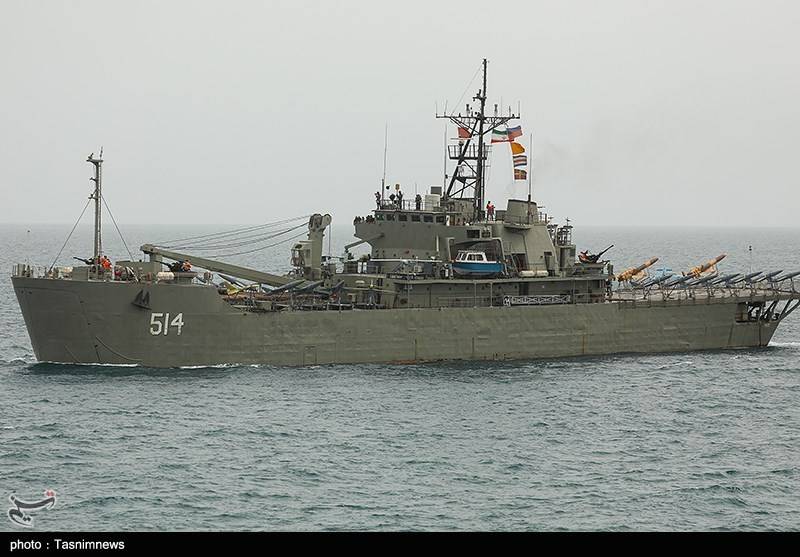
Iran is actively developing its unmanned Aviation and is looking for new ways to use it in the interests of different types of armed forces. So, as part of the South fleet The Navy of the Armed Forces has created a new formation, which includes carrier ships of various types of UAVs. These pennants will conduct patrols and reconnaissance in the Indian Ocean and its seas, and, if necessary, strike.
Special Purpose Connection
The formation of a new formation as part of the Southern Fleet was carried out with the necessary secrecy. How long the necessary measures took is unknown. The creation of a new special-purpose ship division was officially announced on July 15.
On the same day, in the neutral waters of the Indian Ocean, in the presence of the command of the Navy and the armed forces, demonstration exercises of the new formation took place. The crews of ships and submarines launched UAVs of various types and for various purposes, incl. brand new designs. Takeoffs and flights, the performance of training tasks, as well as landing on moving carriers were demonstrated. They also showed the complete procedure for hitting a remote target with loitering ammunition.
It is reported that the main task of the new division will be patrolling and conducting surveillance and reconnaissance on the high seas. With the help of UAVs, ships will be able to cover the situation hundreds of kilometers from the Iranian coast and timely identify emerging threats. At the same time, it is not only about intelligence. On board the ships of the connection there are shock Drones, as well as loitering ammunition - they have to hit the identified targets.
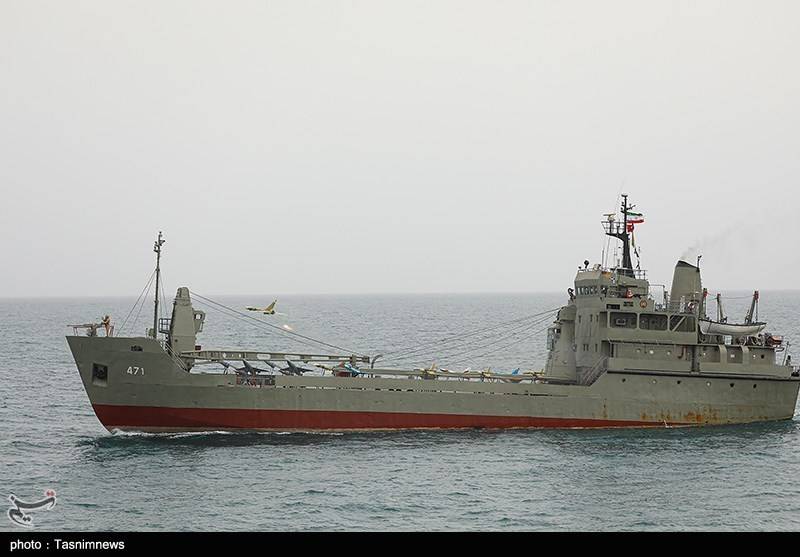
The Iranian command believes that the new special ship formation will become another effective tool aimed at deterring potential adversaries. The need for such an instrument is justified by the deteriorating situation in the region and the aggressive intentions of neighboring countries and their overseas allies.
It is noteworthy that the demonstration exercises of the new formation took place simultaneously with the visit of the US President to Saudi Arabia. With the help of this event, the Iranian leadership reminded Washington and Riyadh of their interests and their readiness to defend them by any means.
Aircraft carriers
The Iranian Navy has revealed some information about its new ship formation, but some of the information has not yet been published. So, the total number of ships and vessels remains unknown, the full list of pennants involved, the number of UAVs on board and the tactical and technical potential are not disclosed. At the same time, recent exercises showed several interesting features of the new division.
First of all, the composition of the ship is interesting. Ships and vessels of various classes have become carriers of drones. So, during the exercises, the largest aviation group was carried by the large landing ship Lavan (514) of the Hengam type. Another "aircraft carrier" was the Devlar transport of the project of the same name. However, the use of diesel-electric submarines Fateh and Taregh in this role is of greatest interest.
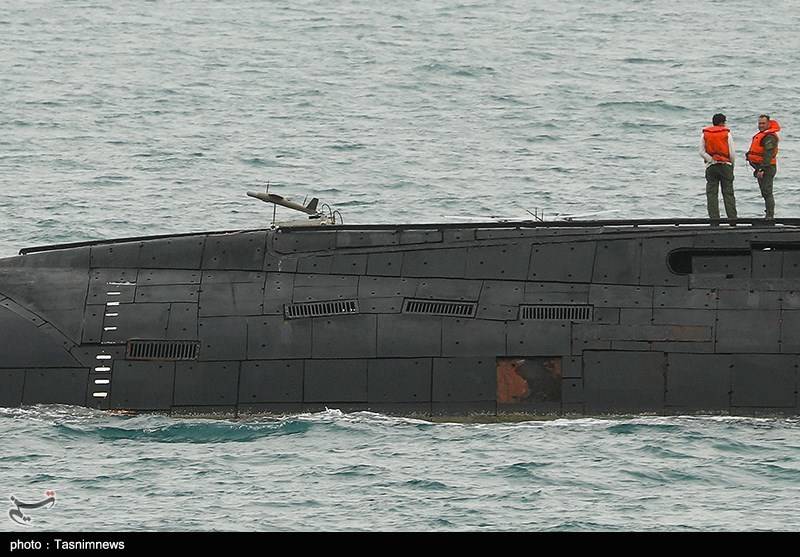
The composition and number of UAVs on board each ship and vessel are determined in accordance with the features of its design and the possibilities for installing additional equipment. Reportedly, the largest available carriers can carry up to 50 drones and deploy dozens of launchers.
Most of the used UAVs start from the launch rail. Such devices are installed in large numbers on accessible deck areas. Even diesel-electric submarines received their guides. Some drones take off from other devices. The method of landing the vehicles is unclear. It is possible to use parachutes, hanging nets or landing on water. There are also VTOL UAVs that only need a platform of sufficient size.
Unmanned Air Fleet
It is reported that the new naval division is armed with UAVs of a number of types of all main classes. Some of these complexes were used in recent exercises or at least were present on the decks. The formation has light and medium drones with reconnaissance and reconnaissance-strike functions.
So, for reconnaissance, the connection can use medium-sized aircraft-type UAVs of the Ababil line, Chamroosh products, etc. The Pelican-2 UAV with vertical take-off and horizontal flight with the help of a wing was also demonstrated.
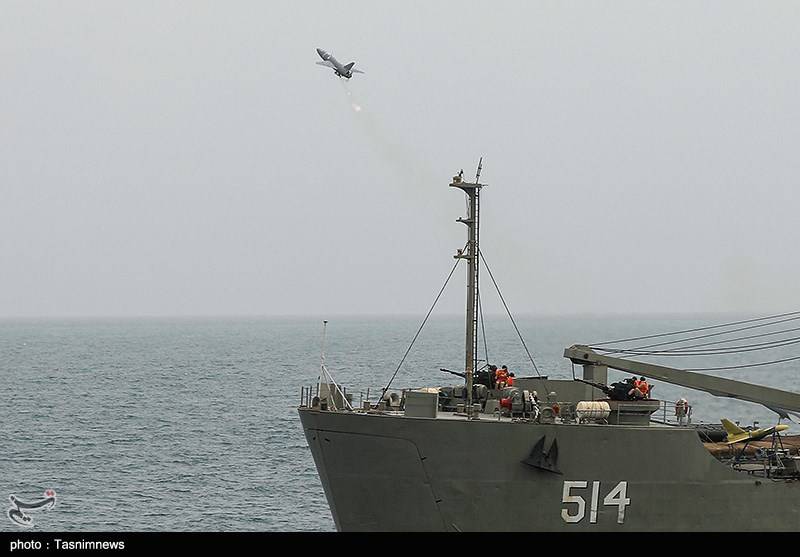
Several types of UAVs can conduct surveillance, search for targets and hit them with their own weapons. For example, the average Ababil-4 takes off with a solid-propellant booster and carries guided bombs. Bavar-5 has similar capabilities. It is possible that other UAVs of this class will be introduced in the future.
The unit can also use loitering ammunition. During the exercises, they showed the launch of the Arash UAV. This product took off from the guide, went to a given area and began patrolling. The operator then found the target and aimed ammunition at it. It is also possible to use the Ababil-2 apparatus in a similar design with a warhead.
New opportunities
The new special formation of the Iranian Navy is of great interest. It was built around an original and promising idea that allows you to get completely new operational capabilities and increase the potential of the fleet. In this case, only available means and components are used, but the introduction of new products in the future is not excluded.
Placement and use of UAVs on ships and support vessels is not news. In addition, there are already projects of "aircraft carriers" equipped with a large number of drones. Iran went further and assembled a whole formation from such ships, the main task of which is to carry and use a large group of various types of unmanned systems. In this regard, the Iranian fleet has bypassed all other countries.
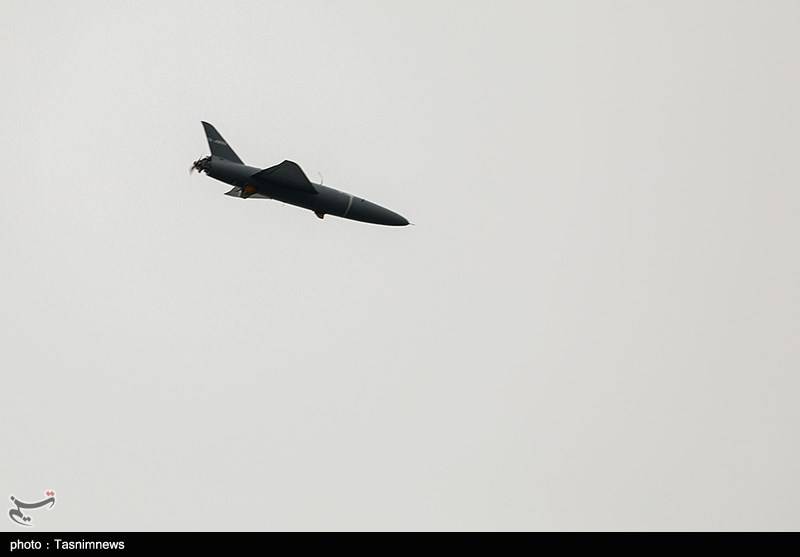
The new naval division includes pennants of various types and classes. The principal possibility of deploying UAVs on landing ships, transport ships and even on submarines is shown. It is likely that ships of other classes will become carriers of large unmanned groups in the future. In this case, the composition, abundance, and other features of the complexes will again be determined taking into account the features of the carrier.
The Iranian aircraft industry is known for its success in the field of UAVs, and they are actively used in a new project for the Navy. It is mentioned that at the current stage, the new formation is armed with seven types of drones. In the future, they can be supplemented and / or replaced by other samples with the necessary characteristics.
In its current form, the aviation group of the compound has broad capabilities. Thus, light and medium-sized UAVs are capable of observing within a radius of tens of kilometers from the carrier, complementing other means of illuminating the situation. Larger samples are characterized by increased range and flight duration. In addition, they are equipped with missile and bomb weapons and are capable of not only noticing targets, but also hitting them.
In fact, around each pennant from the composition of the division, an observation zone with a radius of tens or hundreds of kilometers is formed, incl. with certain strike capabilities. Carrier ships can conduct patrols in one area, complementing each other. They can also operate in different places and increase the size of the controlled zone. It is possible that the connection in its current form is capable of establishing a permanent surveillance of most of the Iranian coast and coastal waters.

However, some shortcomings are also noticeable. Thus, the formation is of particular importance for the Navy and therefore can become a priority target for the enemy. He will try to knock out the UAV carrier ships with the first strike in order to leave the Iranian fleet without reconnaissance. At the same time, the pennants of the compound have limited self-defense capabilities. In addition, it is not clear how many UAVs can simultaneously launch and operate in the air without interfering with each other and without clogging other people's radio channels. Also questionable is the resistance to electronic warfare equipment - both the entire compound and individual complexes.
Experience
Thus, the Iranian Navy was the first in the world to propose and implement the original concept of combining ships and drones to increase the situational awareness of the fleet. Instead of separate UAVs on ships, it was decided to use dozens of devices on several surface and underwater carriers. All this is interesting, at least at the level of the idea and its scale.
Now the Iranian Navy will have to establish a full-fledged service of the new naval division and the operation of all unmanned systems. It is in the process of constant patrolling at sea and on duty in the air that it will be possible to show the full potential of the original idea, confirm its strengths, and also identify shortcomings for correction.
It is likely that foreign fleets will now monitor the service of the new Iranian formation. If it shows itself well and demonstrates in practice all the declared advantages, then other countries in the future will be able to start their experiments of this kind. However, another scenario cannot be ruled out yet, in which the Iranian Navy will reduce the scale of UAV deployment and return to familiar concepts.
Information